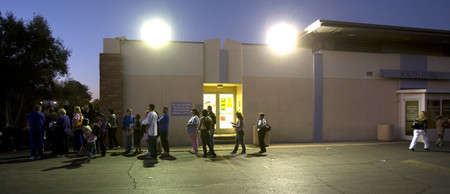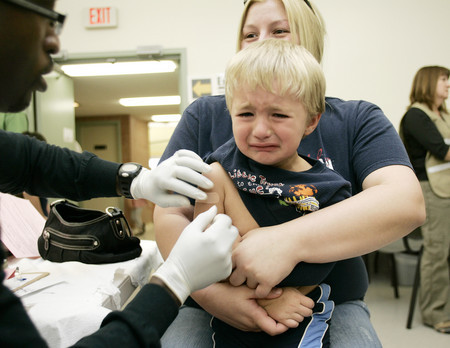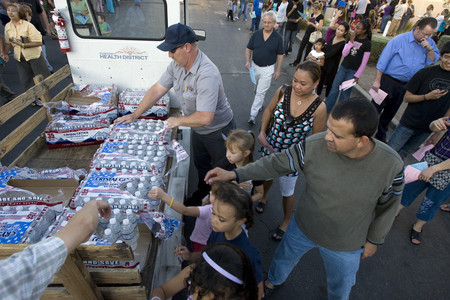Many who got shots at low risk
David Finkelstein isn't an EMT and doesn't have direct daily contact with infants.
Yet he and many other Las Vegans on Thursday received H1N1 vaccinations that health officials have tried to reserve for those most at risk.
All this week, people have not had to demonstrate that they indeed belong to one of the priority groups that the Southern Nevada Health District has stressed should be first in line. So some who aren't in the groups -- the health district doesn't have an estimate of how many -- have still gone home with a Band-Aid on their arm.
Finkelstein, 48, and others said they simply weren't aware of the guidelines. But now the district has run low on the injectable version, and beginning today is making only the inhaled, but less popular, FluMist available until a new supply of shots comes in. That could take seven to 10 days.
At 3 p.m. Thursday, there were roughly 3,000 injectable doses left, said spokeswoman Stephanie Bethel.
That's the only version pregnant women and children with underlying medical conditions -- also priority groups -- are eligible to receive.
"Sure, we've probably had people who aren't in the priority groups (receive shots)," Bethel said. "But we really want people to honor the guidelines. They're there for a reason."
Unfortunately the honor system doesn't seem to be an effective approach in Las Vegas, even if people aren't always intentionally skirting the guidelines.
Finkelstein said he was unaware that the general public wasn't supposed to be eligible for vaccinations for several weeks.
"I didn't know until I found out this morning," he said. "If they tell me I'm not eligible, I will defer my shot so someone else can get it."
But after coming out of the clinic at 625 Shadow Lane, Finkelstein said no one mentioned anything to him about not being eligible. He filled out a standard vaccination form, received his shot, and went on his way.
Bethel said the health district has no plans to implement a stronger screening policy, although it is concerned about potential situations.
"We don't want some pregnant woman to stand in line for hours and for us to run out (of the injectable vaccine)," she said. "That would be a terrible thing."
District staff, however, have been pulling pregnant women out of the lines and bringing them to a room where they could get vaccinated more promptly.
Tom Skinner, spokesman for the Centers for Disease Control, said it's up to the individual providers to determine how to implement the guidelines.
"They have to consider how much of the vaccine they have and how much influenza activity is in the area," he said. "Our recommendations serve as a guide to who we think should be vaccinated first, but ultimately it's up to them."
Susan Shira, 52, a Las Vegas homemaker, also said she wasn't in a priority group and wasn't aware they existed.
Health district officials were outside handing out information to people waiting in line, but no one mentioned anything about eligibility.
"I just figured I was doing a good thing" by receiving the shot, said Shira, who waited in line for an hour.
The shortage came about because of high demand for the shot version and a delay in manufacturers' production of the vaccine, according to the health district.
Nationwide, federal officials initially projected that as many as 120 million doses of the vaccine would be ready to dispense by mid-October. They later reduced their estimate to 45 million. As of Tuesday, 12.8 million were available.
The government now hopes to have about 50 million doses out by mid-November and 150 million in December.
"We need to replenish our supply of the shot," Bethel said. "We've been giving more than 2,000 shots a day (since Saturday), and for the most part, they've requested an injection."
The health district so far has received 49,000 doses of H1N1 vaccine. About 11,000 of those have been distributed to Clark County doctors' offices that serve at-risk populations.
Because of the shortage, the health district also postponed a clinic that was scheduled for Saturday.
The health district has about 18,000 to 20,000 FluMist doses remaining.
Although lines for injectable vaccinations wrapped around the building Thursday morning, there were only about 20 or 30 people in line for the FluMist.
Some people worry about taking FluMist, which is a nasal spray, because it is made with a weakened live virus, tamed in the laboratory so it cannot cause illness.
The shot contains a dead virus.
But health officials say the FluMist is perfectly safe.
"I hope the FluMist line becomes as long as the injectable line," Bethel said. "There's no issue with FluMist. Unfortunately, it hasn't been as popular. But it's a very good alternative."
Contact reporter Mike Blasky at mblasky@reviewjournal.com or 702-383-0283.
Video, slideshow
FLUMIST ELIGIBILITY
The Southern Nevada Health District currently is offering only the FluMist inhaled version of the H1N1 vaccine.
Priority groups eligible for the mist are the following:
People who live with or care for children younger than 6 months old.
Health care and emergency medical services personnel with direct patient contact.
Children between the ages of 2 and 4.
Priority groups ineligible for the mist are the following:
Pregnant women.
Children with underlying medical conditions.




















